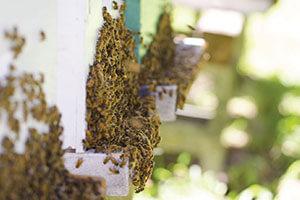
This article marks the end of my short series on honey bee biology. Since my June 2015 article, I have spent considerable time discussing the members of a honey bee colony, their external and internal anatomy, their individual and group behaviors, and even their qualities as a superorganism. I am going to wrap up this series by bringing it all together into this single article on honey bee biology.
Of course, honey bees and their colonies are complicated organisms. A lot is known about honey bees, this due to man’s longstanding relationship with the bee and the bee’s general economic importance. These facts have caused the honey bee to be one of the most studied insects on the planet. Consequently, a short series on various aspects on honey bee biology culminating into this penultimate piece in which I provide a general overview cannot, no matter how hard I try, do justice to the beasts that are the honey bee and its colony. The more I researched to develop these articles, the most I grew to appreciate how amazing honey bees really are. Regardless of the difficulty associated with bringing all of this together into a single treatise, I feel it is important for every beekeeper to have a general understanding of honey bee and colony biology. After all, the best beekeepers know what they are trying to accomplish and what the bees are trying to accomplish. They then work to harmonize the two. No discussion of bee behavior, colony nest architecture, superorganism theory, etc. would be complete without an effort to try to highlight the common thread through all of this. I hope you find this approach useful.
By now, you should have a sense of the difference between the individual honey bee and its colony. I spent quite a bit of time discussing this in my March 2016 article on honey bee colonies as superorganisms (Ellis 2016b). To summarize that article: while the behaviors of the individual bees steer the colony ship, it nevertheless is the colony that is moving forward, regardless of the individual efforts of its crew. Everything an individual bee, from worker to queen to drone, does advances the cause of the colony. The individual’s behavior and resulting biology, while amazing and noteworthy, manifests most perfectly in the attributes of the honey bee colony. Consequently, it will be somewhat difficult to separate the biology of individual honey bees from that of a colony and you might find me switching between the two during this article without announcement.
To understand honey bee biology, you must know what a colony’s goals are. Put simply, a colony’s goals are the same as nearly every organism’s goals. Honey bee colonies want to survive and reproduce. Everything a bee colony does results from wanting to accomplish those two goals. I cannot stress this point enough. The first major desire of a honey bee colony is to survive winter, and to survive it uncompromised, i.e. they want to be healthy and strong on the other side of winter. The second major desire of a honey bee colony is to reproduce, which they accomplish by swarming. Absolutely everything about honey bee colony biology is centered around those two goals.
Of course, there are many possible ways to discuss honey bee biology. However, I find it most helpful to think about the colony’s progression through a typical year, just to give the effort a linear feel. The only problem with this is that one has to deal with the philosophical question of when a colony’s year starts. Most approach their discussion of this topic in winter because it, outwardly, appears to be the time of year when colonies are dormant. However, I find it most helpful to start a discussion of honey bee and colony biology when a new honey bee colony springs into existence. I call this week 0. As noted in my article on superorganisms (Ellis 2016b), that is when a honey bee colony produces a child, when the colony swarms.
One final note: I have decided to …


